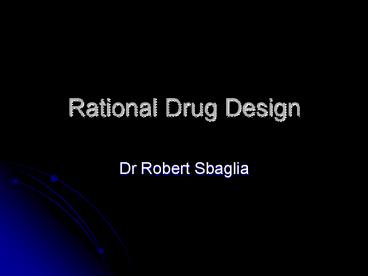Rational Drug Design - PowerPoint PPT Presentation
1 / 25
Title:
Rational Drug Design
Description:
2000 University of Perugia, Italy Alzheimer's Disease. 2003 Postdoctoral Fellowship, University of Florence, Italy - Cancer. Irrational Drug Design? ... – PowerPoint PPT presentation
Number of Views:707
Avg rating:3.0/5.0
Title: Rational Drug Design
1
Rational Drug Design
- Dr Robert Sbaglia
2
Curriculum Vitae
- 1994-1998 Bachelor of Science (Honours),
University of Melbourne - 1998-2002 Doctor of Philosophy, Centre for
Drug Design and Development (later IMB),
University of Queensland Rheumatoid
Arthritis - 2000 University of Perugia, Italy
Alzheimers Disease - 2003 Postdoctoral Fellowship, University of
Florence, Italy - Cancer
3
Irrational Drug Design?
- High Throughput Screening (HTS)
- Expensive
- Slow
- Hit and Miss
- Natural Products (eg Taxol)
- Not easily synthesised
- Not easily modified
4
Taxol
5
Rational Drug Design
- Medical Researchers
- Biologists
- Pharmacologists
- Chemists
- Computational chemists
- Bioinformaticians
- Pharmacists
6
The Process
Identify disease protein
Identify active site
Determine structure of Protein
Virtual Screening of Drug Candidates
Synthesis of Lead Compounds
Pharmacological Testing
Optimisation
Clinical Trials
Drug
7
How Does Drug Design fit into 2008 Chemistry?
- Unit 3, Area of Study 2, Outcome 2
- structure and systematic nomenclature of alkanes,
alkenes, amines, chloroalkanes, alkanols and
carboxylic acids up to C10 - common reactions of organic compounds addition
reactions of alkenes, substitution reactions of
alkanes and primary chloroalkanes, oxidation of
primary alkanols, esterfication - organic reaction pathways including the
production of esters from alkenes, condensation
and polymerisation reactions that produce large
biomolecules - primary, secondary and tertiary structure of
proteins and the function of protein catalysts
(enzymes) - biochemical fuels including fermentation of
sugars to produce ethanol - the structure and bonding of DNA and its
applications in forensic analysis - use of proteins as markers for disease
- function of organic molecules in the design and
synthesis of medicines including the production
of aspirin from salicylic acid.
8
How Does Drug Design fit into 2008 Chemistry?
- Unit 3, Area of Study 1, Outcome 1
- principles and applications of chromatographic
techniques and interpretation of qualitative and
quantitative data from thin layer chromatography
(TLC), high performance liquid chromatography
(HPLC) and gas chromatography (GC) - principles and applications of spectroscopic
techniques and interpretation of qualitative and
quantitative data from atomic absorption
spectroscopy (AAS), infrared spectroscopy (IR),
mass spectroscopy, nuclear magnetic resonance
spectroscopy (NMR), and visible and ultraviolet
spectroscopy (visible-UV) - matching analytical technique/s to a particular
task.
9
Identification of Disease Protein
10
Identification of Disease Protein
11
Identify Active Site
- Mutagenesis studies
- Express proteins with changes in amino acid
sequences - Identify amino acids involved in function
12
Identify Active Site
13
Structure Determination
- X-ray Crystallography
- Nuclear Magnetic Resonance (NMR)
- Homology Modelling
14
Bovine Rhodopsin Crystal Structure
15
Structure Determination
- C5a Receptor
- GPCR
- Membrane Bound
- Homology Model
16
Virtual Screening
- Known structures of organic compounds
- Libraries of Virtual Compounds
- Programs calculate affinity for protein
- Narrow down to small number of possiblities
17
Virtual Screening
18
What makes a good drug?
- Compounds can interact through
- Hydrophobic/hydrophilic pockets
- Charge
- Hydrogen bonding
- Lock and Key
19
Virtual Screening
20
HIV protease
21
Synthesis, Testing and Optimisation
- Small changes to lead compounds
- Must consider
- Solubility
- Specificity
- Bioavailablity
- Toxicity
- Cost
22
Synthesis, Testing and Optimisation
23
Trials
- Animal Model
- Human Trials
- Phase 1 20-80 people
- Phase 2 100-300 people
- Phase 3 1,000 3,000 people
- Phase 4 post-marketing studies
24
(No Transcript)
25
(No Transcript)































